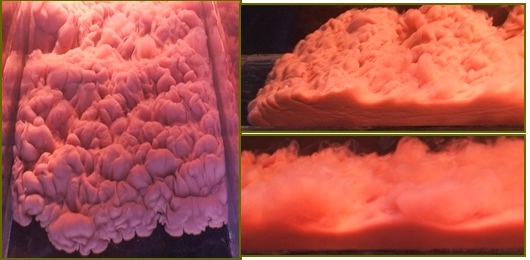|
Project Focus
Dynamics of subaqueous sediment gravity flows
Background
and Motivation
Sediment gravity flows occurs in
a vast variety of environmental,geological, and industrial situations
caused by both natural and man-made causes. Such flows may occur in
both subareal and subaqueous environment in different forms, such as mud flows, debris flows, and turbidity currents.
The main objective of this project was to understand the flow structure
and dynamics of subaqueous fine-grained cohesive sediment gravity
flows. Method
The research was carried out through laboratory experiments that involves
releasing dense fine-grained cohseive sediment suspension (often
referred to as 'fluid mud') under ambient water in a rectangular
flume. Two types of sediments gravity flows were investigated: flows generated from releasing fixed-volume of fluid mud release (dam break, Fig. 1a) and from constant-supply of fluid mud under a gate (Fig. 1b). 
Fig. 1a. Subaquesous fluid mud gravity flows generated by releasing a fixed volume of fluid mud.

Fig. 1b. Subaquesous fluid mud gravity flows generated by releasing a constant -supply of fluid mud. | 
Fig.
2. 3D flow strucutre at the frontal zone of sediment
gravity flows. Lobe-cleft patterns at the leading edge of the
current (left figure), nose and billows above and behind the head of
the current (right-top figure), and decay/breakdown of billows
(right-bottom) behind the nose can be seen. |
Key Findings/Contributions
- First,
I studied the three-dimensional structures at the leading edge of
the gravity flows in the experiments by recording using a
high-definition video camera from the top and side of the tank with
different oblique angles. The currents exhibited three dimensional
flow patterns that consist of protruding regions (lobes) that are
separated by sharp cusps (cleft) at the leading edge of the
current and billows due to gravitational instability that form above
and behind the head of the current (Fig. 2). The results of the study
was appeared in a portfolio paper (Chowdhury et al., 2009).
- Then, I studied propagation characteristics of fixed
volume released fluid
mud gravity flows theoretically and experimentally (Fig. 1a). All the
phases (slumping, inertia- buoyancy, viscous-buoyancy) of the flows
were investigated and modeled by the theoretical models. In paricular,
the investigation showed that Fluid mud gravity flows have a
non-Newtonian rheology and their transition from one phase to another
and propagation characteristics in the viscous phase differ vastlyfrom their Newtonian counterparts. The results of the study was appeared in Chowdhury and Testik (2010).
- Then, I studied propagation characteristics of constant-flux released fluid
mud gravity flows (Fig. 1b).The intial phase for those flows was a wall jet phase, followed by the inertia-
buoyancy and the viscous-buoyancy phase. I developed a box model
for viscous propagation of the flows. Details of the study can be found
in Chowdhury and Testik (2012).
- I have also contributed in a co-authored article (Yilmaz et al., 2014) in which we proposed
frictional resistance parameterizations for fluid mud bottom gravity flows.
Publications
Peer-reviewed journal article: - Yilmaz,
N., Testik, F.Y., and Chowdhury,
M.R., (2014). “Laminar bottom gravity currents: friction
factor-Reynolds number
relationship”, Journal of Hydraulic
Research, IAHR, Vol. 52, No. 4, 545-558. pdf
link
- Chowdhury,
M.R., and Testik,
F.Y., (2012).
“Viscous
propagation of two-dimensional non-Newtonian gravity currents”, Fluid
Dynamics Research, IOPScience, Vol. 44, 045502. pdf
link
- Chowdhury,
M.R., and Testik,
F.Y., (2010). “Laboratory testing of mathematical models for
high-concentration
fluid mud turbidity currents”, Ocean
Engineering, ScienceDirect, Vol.
38, No. 1, 256-270. pdf
link
- Chowdhury,
M.R., Testik, F.Y.,
and Khan, A.A., (2009). “Three-dimensional flow structure at the
frontal zone
of a gravity-driven fluid mud flow”, Journal
of Visualization, Springer, Vol. 12,
No. 4, 273. pdf
link
|


